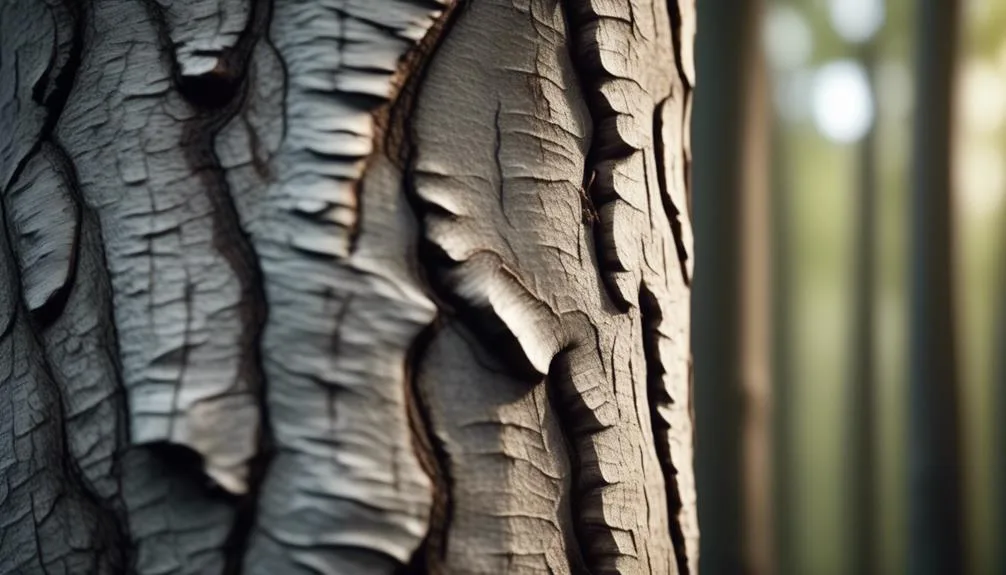Beech trees are known for their smooth, flawless bark that sets them apart in the forest. But there's more to it than meets the eye. The reason behind their sleek appearance unveils a captivating story of survival and adaptation.
Understanding why beech trees have smooth bark reveals a fascinating world of nature's wonders. Stay tuned to discover the intriguing secret behind this distinctive feature of beech trees.
Beech Tree Bark Characteristics
When examining beech tree bark characteristics, you'll notice its smooth, gray surface that sets it apart from the rough, textured bark of many other tree species. This smoothness is a result of the beech tree's unique bark development, which undergoes minimal scaling and flaking as the tree matures.
Unlike other tree species, beech trees have adapted to develop a thin, tight bark that remains relatively unchanged throughout the tree's life. This adaptation serves as a protective layer, shielding the tree from various environmental factors and pests.
The smooth bark also plays a crucial role in preventing water loss and insulating the tree during harsh weather conditions. These tree species adaptations have contributed to the beech tree's distinct appearance and resilience in diverse habitats.
Evolutionary Adaptation of Smooth Bark
How did the beech tree's smooth bark evolve to provide protection and insulation in diverse habitats?
The evolutionary advantage of smooth bark in beech trees is a result of natural selection, where traits that offer better survival and reproduction chances become more prevalent in a population over time.
The smooth bark of beech trees has adapted to provide several benefits:
- Protection: Smooth bark helps deter pests and pathogens, reducing the risk of damage and disease.
- Insulation: The bark acts as a protective layer, shielding the tree from extreme temperatures and fluctuations in climate.
- Moisture Regulation: It assists in preventing excessive water loss and protects against dehydration in arid environments.
- Camouflage: In certain habitats, the smooth bark helps the tree blend in, providing a defense against herbivores and predators.
These evolutionary adaptations have allowed beech trees to thrive in a variety of ecological niches.
Protection Against Herbivores and Pathogens
To safeguard themselves against herbivores and pathogens, beech trees have developed a remarkable defense mechanism through their smooth bark, acting as a natural barrier against potential threats. The smooth bark of beech trees serves as a herbivore deterrent by making it difficult for insects and other animals to climb the tree and feed on its leaves and branches. Additionally, the absence of deep crevices in the bark reduces hiding spots for pathogens and pests, contributing to the tree's disease resistance. This protective adaptation plays a crucial role in the beech tree's ability to thrive in various environments, ensuring its survival and longevity. Below is a table highlighting the key protective features of beech tree bark:
| Protective Feature | Description | Benefits |
|---|---|---|
| Smooth Texture | Acts as a herbivore deterrent by hindering climbing | Reduces feeding damage and stress on the tree |
| Lack of Deep Crevices | Limits hiding spots for pathogens and pests | Enhances disease resistance and overall health |
| Protective Chemicals | Natural compounds in the bark deter herbivores | Further discourages feeding and prevents damage |
Understanding these protective mechanisms sheds light on the resilience of beech trees in the face of environmental challenges.
Environmental Factors Influencing Bark Texture
As you explore the environmental factors influencing bark texture, you'll discover the pivotal role played by the smooth bark of beech trees in adapting to various surroundings. These ecological factors greatly influence the texture of the bark, shaping the tree's ability to thrive in diverse environmental conditions.
- Climate: The temperature and moisture levels in an area significantly impact the development of beech tree bark, leading to variations in texture.
- Soil Composition: Different soil types affect the availability of nutrients and water, influencing the bark's texture and resilience.
- Sunlight Exposure: The amount of sunlight a beech tree receives can impact its bark texture, affecting its ability to withstand environmental stressors.
- Natural Disturbances: Events such as fires, flooding, or windstorms can influence the texture of beech tree bark, reflecting the tree's resilience to such environmental conditions.
Unique Properties of Beech Tree Bark
Beech tree bark possesses a remarkable smoothness that sets it apart from other tree species, contributing to its adaptability and ecological significance.
The bark texture of beech trees is unusually smooth, lacking the deep furrows and ridges seen in many other tree species. This unique property provides a protective barrier against parasites and diseases, as it makes it difficult for organisms to find crevices to infiltrate.
The smooth bark also helps regulate the tree's temperature, reducing the risk of frost cracks and sunscald. Furthermore, the absence of deep crevices makes it harder for invasive species to establish themselves, adding to the ecological benefits of beech trees.
This distinctive feature underscores the adaptability and resilience of beech trees in diverse environmental conditions.
Conclusion
Next time you encounter a beech tree with its smooth, silvery bark, take a moment to appreciate how this unique feature has contributed to the tree's resilience and survival.
It serves as a reminder of nature's remarkable ability to adapt and thrive in its environment, offering a glimpse into the fascinating ways in which plants ensure their own existence.

My interest in trees started when I first saw the giant sequoias in Yosemite.
I was a teenager then, and I remember thinking, “I need to learn more about this.”
That moment stuck with me.
A few years later, I went on to study forestry at Michigan Tech.
Since graduating, I’ve worked in a mix of hands-on tree care and community education.
I’ve spent over ten years helping people understand how to plant, maintain, and protect the trees in their neighborhoods.
I don’t see trees as just part of the landscape.
They are living things that make a real difference in our daily lives.
